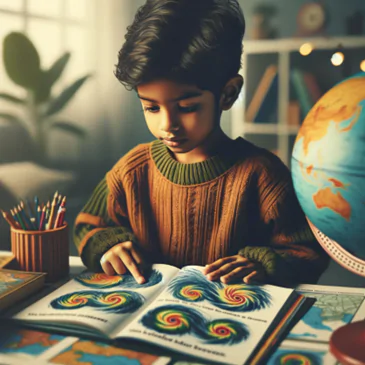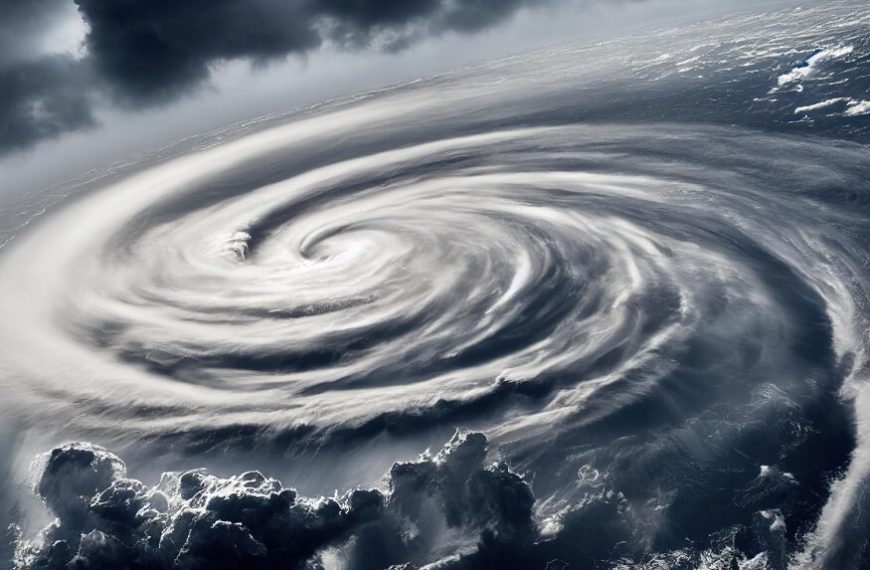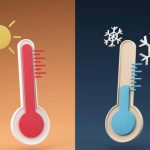Cyclones are natural disasters that evolve over warm sea waters. They are strong storms that can lead to property loss and human lives.
Cyclones can be divided into several degrees, starting from tropical disturbances and extending to storms of Category 5, depending upon the temperature, the rotation of the earth, and the Coriolis force. It is therefore important for people to be well informed on the various types and causes of cyclones, their stages, and measures to be taken during cyclones. In this article, we will discuss cyclones in detail.
What is a Cyclone?
The word ‘Cyclone’ was coined by metrologist Henry Paddington. It is derived from a Greek word called ‘Cyclos,’ which refers to the coils of a snake. As mentioned before, a cyclone is a large atmospheric system characterized by low pressure at its center and rotating winds that converge inward. Cyclones can lead to severe weather conditions, including strong winds and heavy rainfall. They often form over warm ocean waters, and their intense storms can cause widespread damage through high winds, flooding, and storm surges.
What are the Causes of a Cyclone?
To fully understand cyclones, it’s crucial to understand the conditions that lead to their formation. Cyclones arise from environmental factors that create and sustain their powerful systems.
Here are the key causes of cyclones:
- Warm Sea Surface Temperatures: Heat from the ocean is one of the main causes of cyclones. This heat provides the energy needed to fuel a cyclone.
- Coriolis Force: The Earth’s rotation creates a force that initiates the spinning motion of the cyclone.
- Atmospheric Instability: Differences in air pressure and temperature can create instability, which can be one of the causes of cyclones.
- High Humidity: Increased moisture in the lower and middle levels of the troposphere sustains the cyclone’s strength.
- Low Vertical Wind Shear: Minimal difference in wind speed and direction at various altitudes allows the cyclone to grow undisturbed.
- Pre-Existing Low-Pressure Zones: Areas of disturbed weather or low pressure often act as the seeds for cyclone formation.
How Are Cyclones Formed?
Cyclones dissipate due to their movement over cooler waters and create adverse weather conditions. Now, let us understand the four stages of cyclone formation.
- Cyclones are formed over the surface of warm ocean waters. The surface temperature must be at least 26.5 degrees Celsius (80 degrees Fahrenheit).
- As warm water rises into the atmosphere, a region with reduced atmospheric pressure is created below.
- The warm air that has ascended then cools and condenses to form clouds. The Coriolis effect, caused by the earth’s rotation, causes the warm air to rotate in an anticlockwise direction in the Northern Hemisphere and clockwise in the Southern Hemisphere.
- The rotating clouds continue to increase, powered by warm ocean waters. As a result of the circular pattern of strong winds and heavy rain, a cyclone is formed.
The centre of the cyclone is calm and clear. It is also known as the eye of the cyclone and is also the place from where the air descends. Around the eye is the eyewall, where the strongest precipitation and winds occur.

Types of Cyclones
There are four types of cyclones:
Tropical cyclone
. Polar cyclone
. Mesocyclone
. Extratropical cyclone
Let’s have a look at these types of cyclones in detail.
- Tropical Cyclone
- Polar Cyclone
- Mesocyclone
- Extratropical Cyclone
The regions where the tropical cyclone occurs are over the tropical ocean. It is also called hurricanes or typhoons. There are few hurricanes in some parts of the world, and they are experienced only in the Atlantic and Northeast Pacific. A tropical cyclone can be classified into five groups, based on the level of storm and the wind that it generates.
The polar cyclone refers to the cyclone that develops at high latitudes and is sometimes referred to as the “Arctic hurricane” in the Northern Hemisphere. One of the mechanisms is the heat exchange from water to air and the latent heat release in the form of condensation of clouds. Predicting the polar cyclones may be hard since they take less than twenty-four hours to formulate. Polar cyclones form over the Arctic and the Antarctic oceans.
The mesocyclone is one of the most serious thunderstorms. The mesocyclone is present inside the convective storm through swirling or rotating air. Because of the Coriolis force of the Earth’s rotation, the air rises and rotates along the vertical axis. Both of these are aligned in the given hemisphere, which is the direction of this air and low pressure. As a result, the mesocyclone takes place alongside the rotating air within the thunderstorm.
The cyclones that evolve in the middle latitude in relation to the frontal boundaries are termed extratropical cyclones or the mid-latitude cyclones. The winds of the extratropical cyclone are not as strong as those of the tropical cyclone. However, the temperature gradients are steep. For example, the Nor’easter storm is an extratropical cyclonic storm that affects the United States’ eastern region.
Categories of Cyclone
Cyclones are classified into categories based on their wind speed, which helps estimate the level of damage they might cause upon landfall. The table below highlights the five categories of cyclones:
|
Category |
Wind Speed (in kmph) |
Damage at Landfall |
|
1 |
119-153 |
Minimal |
|
2 |
154-177 |
Moderate |
|
3 |
178-210 |
Extensive |
|
4 |
211-250 |
Extreme |
|
5 |
More than 250 |
Catastrophic |
Understanding Tropical Cyclones Origin in India
The spiral movements of the cyclone can become extremely powerful and cause winds, rainfall, harsh storms, and devastating damage in the coastal areas. The classification and naming convention of a cyclone depends on the region. For instance, in the Western North Pacific, they are known as typhoons, while in the Eastern North Pacific, they are referred to as hurricanes.
Depending on the type, cyclones are also classified as typhoons or hurricanes. In India, cyclones occur over the coastlines on both the eastern and western sides. In fact, the Bay of Bengal is one of the most active cyclone basins in the world. Some states that are affected by cyclones include West Bengal, Odisha, Andhra Pradesh, and Tamil Nadu. Although less prone to cyclones compared to the Bay of Bengal, the Arabian Sea, which lies on the western side of India, also sees cyclones, mainly during pre and post-monsoon periods. States like Kerala and Karnataka are states affected by these cyclones.
The 8 Different Levels of a Cyclone
Hope you caught the cyclone meaning. Cyclones love playing games just like you and play in 8 different levels. Hop on board to understand various the levels of a tropical cyclone.
Level 1 – Tropical Disturbance
The first level of a cyclone begins as a cluster of thunderstorms that form over warm ocean waters. You cannot see any spinning around in this stage.
Level 2 – Tropical Depression
In this level, you can see a spinning pattern with steady winds of up to 61.15 kilometres per hour or 33 knots. A knot is a unit of speed used in maritime and aviation, in which one knot is equal to 1.852 kilometres per hour and one nautical mile the same as 1.852 kilometres.
Level 3 – Tropical Storm
Hold on tight; the game is getting stronger, champ! Now, let us learn about the types of cyclones.
As the steady winds reach 34 to 63 knots, the process is referred to as a tropical storm and is given a name at this point. What are tropical cyclones? Tropical cyclones are named by following the rules set at the regional levels. In the Southern hemisphere, which is the Indian Ocean and South Pacific, cyclones are named in alphabetical order, with women’s and men’s names being alternated.
Level 4 – Type 1 Cyclone
When the steady winds reach 64 to 82 knots, it is known as a Category 1 cyclone in the Southwest Indian Ocean and South Pacific. In this stage, trees and homes are damaged, which can also lead to minor flooding cases in the coastal areas.
Level 5 – Type 2 Cyclone
In this stage, the steady winds reach 83 to 95 knots. At this level, the cyclone can cause great damage.
Level 6 – Type 3 Cyclone
At this stage, the cyclone is labelled a major one. As the sustained winds range from 96 to 112 knots, these storms can cause devastating damage.
Level 7 – Type 4 Cyclone
This stage can cause catastrophic damage to the entire ecosystem it meets. The storm is extremely dangerous and the sustained winds reach 113 to 136 knots.
Level 8 – Type 5 Cyclone
The final stage of the cyclone, sustained winds reach 137 knots and are reserved for the most intense and fatal storms.Names of Cyclones
|
Region |
Other names of cyclones |
|
Caribbean sea |
Hurricanes |
|
China sea |
Typhoons |
|
Indian ocean |
Tropical cyclones |
|
Japan |
Taifu |
|
Northern Australia |
Willy willies |
|
Philippines |
Baguio |
|
USA |
Tornadoes |
How To Stay Super Safe When a Cyclone Comes Swirling Your Way?
Explore these seven tips that can help you keep super safe during cyclones.
- Stay informed and constantly monitor weather updates from credible and verified sources.
- Familiarise yourself with shelters, evacuation routes, and plans designed by your local government.
- Close all your windows and doors and reinforce them with sturdy materials like plywood.
- Stock emergency supplies like food, medical kits, water, non-perishable food, important documents, batteries, and flashlights.
- Turn off gas, electricity, and water supplies to prevent potential hazards.
- Charge all devices beforehand and only use them for emergencies.
- Try to stay calm and only venture out when authorities declare it safe to do so.
Conclusion
In conclusion, cyclones are powerful forces of nature that cause mass destruction. They are huge air masses that swirl and rise around a low-pressure area. We also learned how the Coriolis effect influences the rotational speed of the cyclone. The regions frequently affected by cyclones in India are West Bengal, Odisha, Andhra Pradesh, and Tamil Nadu. Now that you understand cyclones’ meaning and types, as well as the causes of cyclones, share this information with your friends and family. If you are interested in knowing more about natural disasters, check out our blog, The Terrifying Power of Tsunamis: Causes, Facts, and Safety, to learn interesting facts about tsunamis. You can also check out EuroKids Blog for interesting insights into your little one’s health, nutrition, and development. Do check out our nationally recognized preschools– EuroKids for the first step in your kid’s educational journey!
















